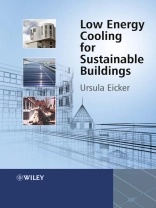This long-awaited reference guide provides a complete overview of
low energy cooling systems for buildings, covering a wide range of
existing and emerging sustainable energy technologies in one
comprehensive volume. An excellent data source on cooling
performance, such as building loads or solar thermal chiller
efficiencies, it is essential reading for building services and
renewable energy engineers and researchers covering sustainable
design.
The book is unique in including a large set of experimental
results from years of monitoring actual building and energy plants,
as well as detailed laboratory and simulation analyses.
These demonstrate which systems really work in buildings, what the
real costs are and how operation can be optimized – crucial
information for planners, builders and architects to gain
confidence in applying new technologies in the building sector.
Inside you will find valuable insights into:
* the energy demand of residential and office buildings;
* facades and summer performance of buildings;
* passive cooling strategies;
* geothermal cooling;
* active thermal cooling technologies, including absorption
cooling, desiccant cooling and new developments in low power
chillers;
* sustainable building operation using simulation.
Supporting case study material makes this a useful text for
senior undergraduate students on renewable and sustainable energy
courses. Practical and informative, it is the best up-to-date
volume on the important and rapidly growing area of cooling.
สารบัญ
Preface.
About the Author.
1 Energy Demand of Buildings.
1.1 Residential Buildings.
1.1.1 Heating Energy.
1.1.2 Domestic Hot Water.
1.1.3 Electricity Consumption.
1.2 Office Buildings.
1.2.1 Heating Energy.
1.2.2 Electricity Consumption.
1.2.3 Air Conditioning.
1.3 Conclusions.
2 Façades and Summer Performance of Buildings.
2.1 Review of Façade Systems and Energy Performance.
2.1.1 Single Façades.
2.1.2 Double Façades.
2.1.3 Modelling of Ventilated Façades.
2.2 Experimental Results on Total Energy Transmittance.
2.2.1 Laboratory Experiments.
2.2.2 Building Experiments.
2.3 Cooling Loads through Ventilation Gains.
2.3.1 Double Façade Experiments.
2.3.2 Parameter Study Using Simulation.
2.4 Energy Production from Active Façades.
2.4.1 Thermal and Electrical Energy Balance of the Façade.
2.5 Conclusions on Façade Performance.
3 Passive Cooling Strategies.
3.1 Building Description and Cooling Concepts.
3.1.1 Lamparter Building, Weilheim.
3.1.2 Rehabilitated Office Building in Tübingen.
3.1.3 Low-energy Office Building in Freiburg.
3.2 Passive Night Ventilation Results.
3.2.1 Internal Loads and Temperature Levels.
3.2.2 Air Changes and Thermal Building Performance.
3.2.3 Simulation of Passive Cooling Potential.
3.2.4 Active Night Ventilation.
3.3 Summary of Passive Cooling.
4 Geothermal Cooling.
4.1 Earth Heat Exchanger Performance.
4.1.1 Earth to Air Heat Exchanger in a Passive Standard Office Building.
4.1.2 Performance of Horizontal Earth Brine to Air Heat Exchanger in the ebök Building.
4.1.3 Performance of Vertical Earth Brine to Air Heat Exchangerin the SIC Building.
4.1.4 Modelling of Geothermal Heat Exchangers.
4.1.5 Conclusions on Geothermal Heat Exchangers for Cooling.
5 Active Thermal Cooling Technologies.
5.1 Absorption Cooling.
5.1.1 Absorption Cycles.
5.1.2 Solar Cooling with Absorption Chillers.
5.2 Desiccant Cooling.
5.2.1 Desiccant Cooling System in the Mataró Public Library.
5.2.2 Desiccant Cooling System in the Althengstett Factory.
5.2.3 Monitoring Results in Mataró.
5.2.4 Monitoring Results in Althengstett.
5.2.5 Simulation of Solar-Powered Desiccant Cooling Systems.
5.2.6 Cost Analysis.
5.2.7 Summary of Desiccant Cooling Plant Performance.
5.3 New Developments in Low-Power Chillers.
5.3.1 Development of a Diffusion-Absorption Chiller.
5.3.2 Liquid Desiccant Systems.
6 Sustainable Building Operation Using Simulation.
6.1 Simulation of Solar Cooling Systems.
6.1.1 Component and System Models.
6.1.2 Building Cooling Load Characteristics.
6.1.3 System Simulation Results.
6.1.4 Influence of Dynamic Building Cooling Loads.
6.1.5 Economic Analysis.
6.1.6 Summary of Solar Cooling Simulation Results.
6.2 Online Simulation of Buildings.
6.2.1 Functions and Innovations in Building Management Systems.
6.2.2 Communication Infrastructure for the Implementation of Model-Based Control Systems.
6.2.3 Building Online Simulation in the POLYCITY Project.
6.3 Online Simulation of Renewable Energy Plants.
6.3.1 Photovoltaic System Simulation.
6.3.2 Communication Strategies for Simulation-Based Remote Monitoring.
6.3.3 Online Simulation for the Commissioning and Operation of Photovoltaic Power Plants.
6.3.4 Summary of Renewable Energy Plant Online Simulation.
7 Conclusions.
References.
Index.
เกี่ยวกับผู้แต่ง
Ursula Eicker is a physicist who carries out international research projects on solar cooling, heating, electricity production and building energy efficiency at the University of Applied Sciences in Stuttgart. She obtained her Ph D in amorphous silicon thin-film solar cells from Heriot-Watt University in Edinburgh and then worked on the process development of large-scale amorphous silicon modules in France. She continued her research in photovoltaic system technology at the Centre for Solar Energy and Hydrogen Research in Stuttgart. She set up the Solar Energy and Building Physics Research Group in Stuttgart in 1993. Her current research emphasis is on the development and implementation of active solar thermal cooling technologies, low-energy buildings and sustainable communities, control strategies and simulation technology, heat transfer in façades, etc. Since 2002 she has been the scientific director of the research centre on sustainable energy technologies (zafh.net) in Baden Württemberg. She also heads the Institute of Applied Research of the University of Applied Sciences in Stuttgart, where building physicists, geoinformation scientists, mathematicians, civil engineers and architects cooperate. During the last 10 years Professor Eicker has coordinated numerous research projects on sustainable communities with renewable energy systems and highly efficient buildings. The largest projects include the European Integrated POLYCITY Project, a demonstration project on sustainable buildings and systems in Germany, Italy and Spain, and the European Ph D school CITYNET on information system design for sustainable communities.












